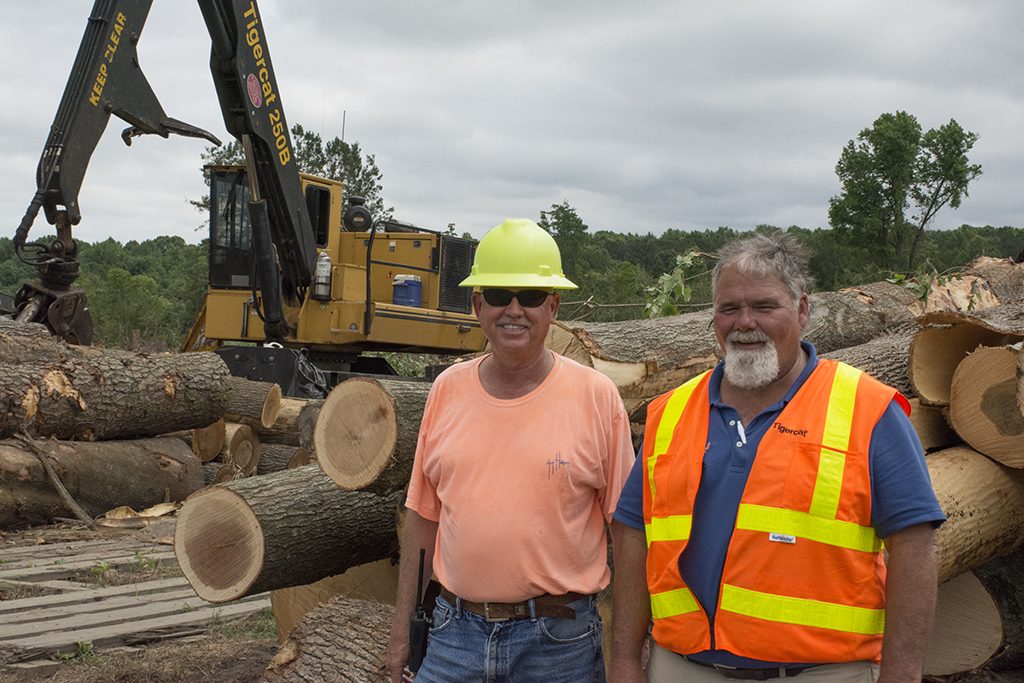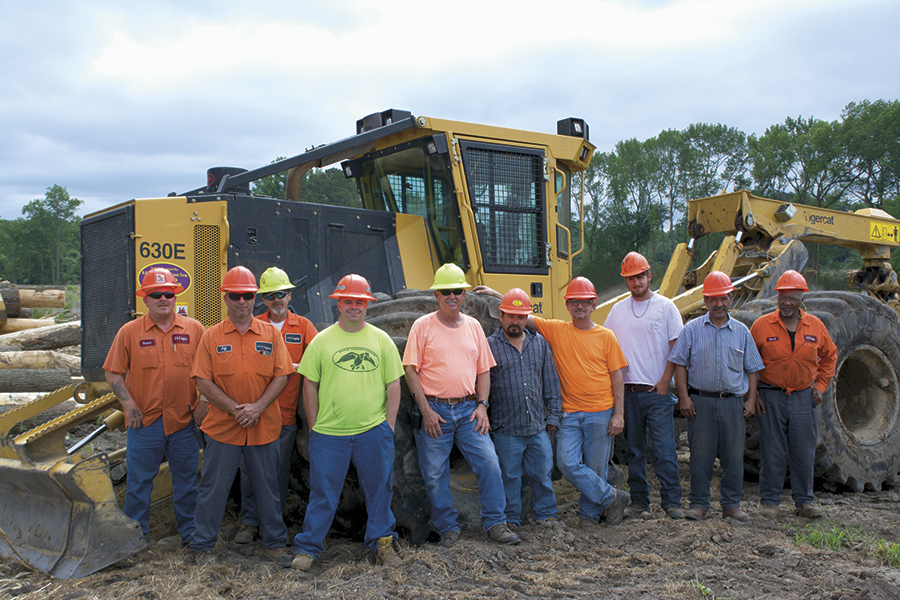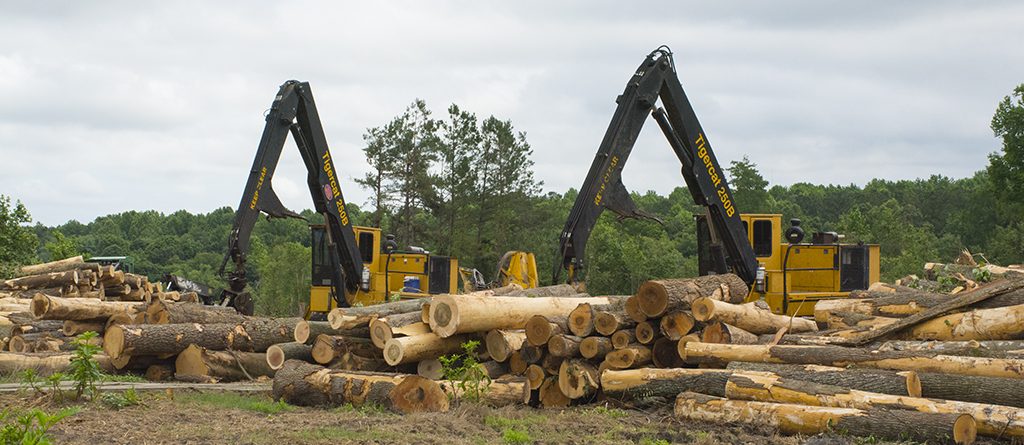21st November 2016
BTB visited Castalia, North Carolina to speak with Joedy Cahoon about his family operations, preferred equipment and prime harvesting methods.
– Samantha Paul, Tigercat marketing
Brothers Joedy and Ronnie Cahoon are third generation loggers who know the timber business like few others. Joedy and Ronnie both own and operate their own logging companies. Joedy owns J & R Logging and Ronnie owns Cahoon Brothers Logging. In addition, the brothers comanage their mother Christine’s company, Cahoon Logging, which she took responsibility for when her husband, Carlton Joedy Cahoon Sr. passed away. With their mom by their side, the Cahoons continue to take pride in their business and family name.

Joedy Cahoon (left) and CTW Equipment sales specialist, Donald Smith. “CTW is first class and I can always count on Donald if I need anything,” claims Joedy.
Not only are the Cahoons keeping the logging business in the family, they are now keeping it in the Tigercat family, gradually switching from Deere to Tigercat equipment. Joedy was first introduced to Tigercat in 1995 when he saw an advertisement for a 726 feller buncher in a local magazine publication. “I knew just by the photo that somebody had done their work,” claims Joedy. So he tried one out.

The men of J & R Logging. (L-R) Chris Respess, Jeff Bell, Jason Respass, James Foster, Joedy Cahoon, Goreio Martinez, Billy Joe Boyd, Aaron Warren, Loco Ramirez and Tommy Baldwin.
That same year, Joedy purchased the 36th Tigercat 726 ever to be produced. “Tigercat mastered the weak parts,” says Joedy. “The centre section was always the weakest part on cutters and it would beat a man up sitting in it all day, wobbling back and forth. But with Tigercat this doesn’t happen and I have never had to replace a centre section.” Joedy then decided to switch over his loaders to Tigercat models and started thinking about Tigercat skidders, “I always wanted a tractor with a big bucket on it,” he says.
In 2005, Joedy purchased his first Tigercat skidder, a 620C from Jimmy Harris, whom at the time was sales specialist for Tigercat dealer A.G. Lassiter. Joedy initially ordered the machine with the standard 1,39 m² (15 ft²) grapple but then he found himself getting into some tracts where the hardwood was not heavy but bulky, short and hard to handle. Joedy then decided to put an order in with A.G. Lassiter for a larger 1,58 m² (17 ft²) grapple. By mistake, a 1,72 m² (18.5 ft²) grapple – typically equipped on a 630 skidder – ended up on the machine. This was a very lucky mistake for Joedy. He couldn’t have been happier, thinking that the oversize grapple would be perfect for his operations.
Now that my operators have tried Tigercat, that is all they want to run.
– Joedy Cahoon, owner of J & R Logging
The bigger grapple went a long way toward maintaining a steady flow for the chipping operations. “Normally we run two chippers and it takes a lot of wood to run two of them. Before the skidders get out of eye sight to get another load the chippers were already done, but those Tigercat skidders with the big tongs will get enough wood for both before all the wood is eaten up,” claims Joedy.

Joedy comments on this oldest 250B loader (right) purchased in 2006, “I have run some smooth loaders but nothing will last 22,000 hours like my Tigercat.”
After the mistake was revealed, Tigercat engineering spent some time investigating and learning more about Joedy’s operations. Considering all the factors involved and the type of operation, the final decision was to leave the 620C as it was minus the remaining warranty. Joedy agreed based on his high level of confidence in Tigercat and the quantifiable improvements in his chipping operations. Eleven years later with 24,000 hours on the machine, the configuration is still working very well for Joedy.
Joedy’s current Tigercat equipment fleet includes four drive-to-tree feller bunchers – a 720, two 724Gs and one 726B – as well as an 860 track feller buncher. He also operates three 250B trailer mounted loaders and one T250B track loader. The most recent addition to his line-up is a 2016 630E skidder purchased through sales specialist Donald Smith of CTW Equipment. In addition, he still has his eleven-year-old 620C skidder and a 2014 630E. Soon he plans to replace an older 2006 model 250B with a second track loader for additional shovel logging capability. Between the three Cahoon companies, they try to upgrade five to six machines each year.
Joedy has a crew of eleven employees on his site. Foreman, Jeff Bell zeroes in on why he thinks Tigercat equipment lasts so long, “It’s the hydraulic equipment. Tigercat runs so cool,” he says. “You get off a Prentice and you lay your hand on a cylinder and it would be scalding hot and the o-rings would be cooked hard. But with Tigercat, you could touch the cylinder for a while. You can really tell the difference.”
Unlike the frozen ground in cold and snowy Canada – which Joedy likes to visit in winter to hunt whitetail deer – J & R Logging cuts tracts along the coast of North Carolina, an area often hit with tropical storms that bring along massive amounts of precipitation, causing river and coastal flooding.
Based on their many years of experience logging in the area, the Cahoon brothers know how to survive the wet conditions with traditional shovel logging techniques. They will use a track feller buncher and track loader to build roads to the landing. Once they are finished logging a sector, the skidders will remove the temporary road and skid those logs to roadside as well. Their trick when building log roads is to put the butts of the trees toward the deck, making it easier for the skidder to remove them when they are done. “You can either sit at home and wait for the rain to dry up or you can get yourself a shovel and keep moving timber,” says Joedy.
Joedy’s mother, Christine “Mama” Cahoon, logs most of her tracts for Weyerhaeuser. Earlier this year they got word from Weyerhaeuser that they were the only company that did not have to stop operations due to rain so far in 2016. Other contractors had multiple tracts that they started but couldn’t finish due to wet weather. Going back later to finish and clean up once conditions improve can be a waste of time and money. “You never go in and cut all the front of your timber out. That is a no-no,” says Joedy. “If it gets wet, you have no wood close by to build a road to your deck. Continuously cut front to back,” he explains.
These days, Joedy’s wood averages 46 cm (18 in) in diameter. The chips are sent to the Enviva pellet mill in Ahoskie, North Carolina. Round wood goes to North Hampton County, North Carolina. Joedy aims for 25 loads per day whereas his mom aims for about 50 to 60 loads per day. “It’s a different beast with the bigger timber on Mama’s job,” says Joedy. “All the trees are in nice neat rows but you get paid less so you have to move more wood.”
Looking back Joedy is happy he took the chance on that new Tigercat 726 feller buncher soon after it was introduced to the market. This year marks Joedy Cahoon’s 40th year in the logging business. It took hard work, careful planning and the right equipment to get to where he is now.